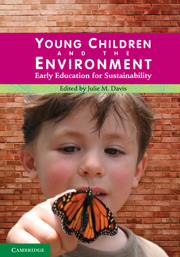Book contents
- Frontmatter
- Foreword
- Contents
- List of contributors
- Introduction
- PART 1
- PART 2
- Chapter 6 Repositioning an ethic of sustainability in early childhood education, with Reconciliation as central
- Chapter 7 The world is flat: ICT and education for sustainability in the early years
- Chapter 8 Healthy and sustainable environments for children and communities
- Chapter 9 Creating deep and broad change through research and systems approaches in early childhood education for sustainability
- Endnote
- Index
- References
Chapter 8 - Healthy and sustainable environments for children and communities
from PART 2
- Frontmatter
- Foreword
- Contents
- List of contributors
- Introduction
- PART 1
- PART 2
- Chapter 6 Repositioning an ethic of sustainability in early childhood education, with Reconciliation as central
- Chapter 7 The world is flat: ICT and education for sustainability in the early years
- Chapter 8 Healthy and sustainable environments for children and communities
- Chapter 9 Creating deep and broad change through research and systems approaches in early childhood education for sustainability
- Endnote
- Index
- References
Summary
EDITOR'S NOTE
Sue Cooke, in this chapter, focuses on the close connections between environmental and sustainability issues and human health. She outlines how the changing ecology of childhood is raising some profound challenges for child (and adult) health and wellbeing, and cites research suggesting all is not well. Sue proposes that learning associated with school community gardens and travel-to-school practices, for example, offer opportunities for linking health and environmental concerns and educational responses. She also identifies synergies and opportunities between environmental and sustainability programs and projects in educational settings with international movements such as Health Promoting Schools and Child Friendly Cities.
Another potential linkage Sue makes is between health professionals and early childhood educators; she advises that they work together more closely than at present, with the aim of creating ‘green and healthy’ learning environments for young children, rather than seeing these as two separate goals. In essence, living sustainably is not only good for the planet but also for the health and wellbeing of children, families and communities.
INTRODUCTION
Research on child health and development has shown that the environments young children experience as they are growing shape their health and wellbeing. This means not only the social or human environments, especially the family, but also the physical, geographical, built and natural environments. These environments begin to have an impact on the developing child, arguably, from the moment of conception, through infancy, childhood and adolescence.
- Type
- Chapter
- Information
- Young Children and the EnvironmentEarly Education for Sustainability, pp. 242 - 272Publisher: Cambridge University PressPrint publication year: 2010
References
- 1
- Cited by



